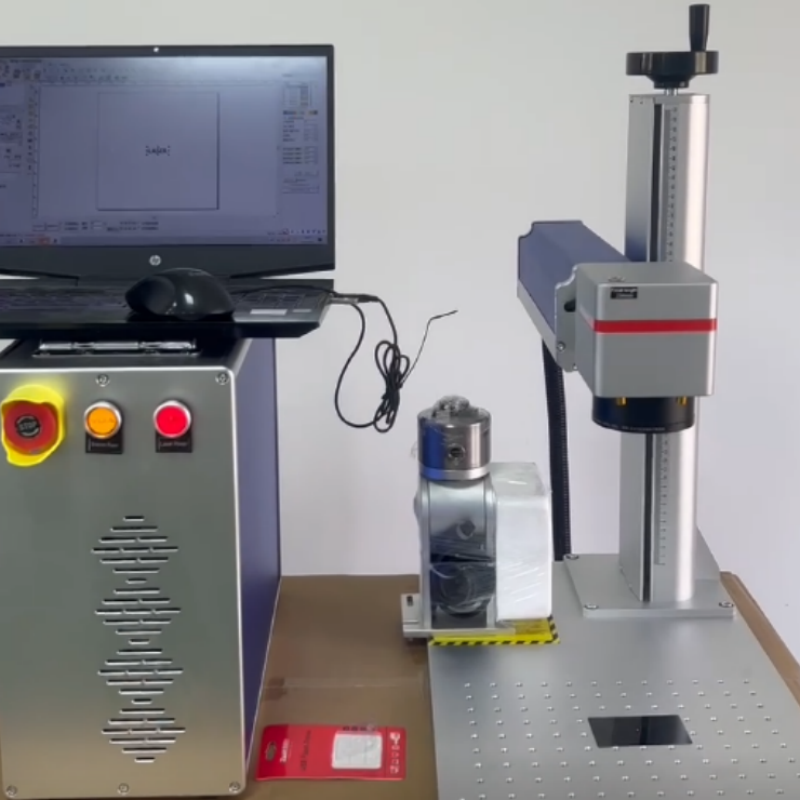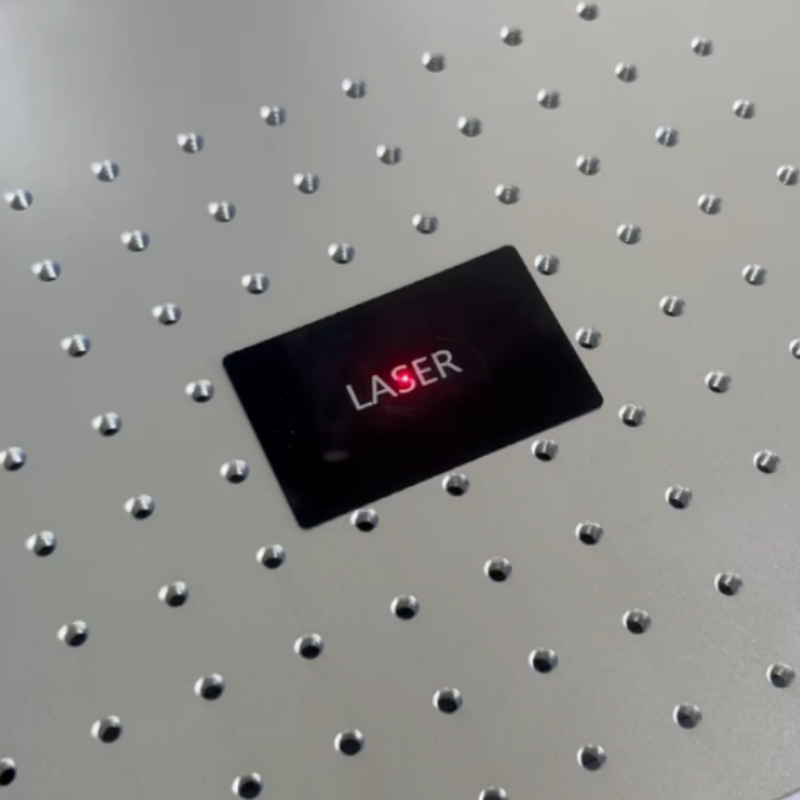- Major Differences in Principle
(I) Laser Marking Machine
Laser marking machines use a high-energy-density laser beam to instantly strike the surface of a workpiece. During this process, the surface layer of the material rapidly absorbs the laser energy, either directly vaporizing due to the high temperature, revealing the underlying material, or triggering a photochemical reaction that changes the material’s color, thereby precisely “engraving” the desired pattern, text, and other information. The entire marking process involves a microscopic transformation of the interaction between light energy and matter, and is highly dependent on the laser’s precise focusing and energy control.
(II) Traditional Silk Screen Printing
Traditional silk screen printing requires the creation of a screen. A lacquer film is then manually engraved or photochemically applied onto a silk, synthetic fiber, or metal mesh, leaving the mesh openings transparent in the image area and obstructed in the non-image area. During printing, ink is applied to one end of the screen. A squeegee applies pressure and moves at a constant speed, forcing the ink through the image mesh and onto the workpiece surface below, creating an image that matches the original. This process is similar to ink leaking through a filter screen, with physical compression being the key driver of the ink transfer.
- Efficiency vs. Flexibility
(I) Laser Marking Machines
Leveraging software control, laser marking machines eliminate the need for plate-making, allowing for instant switching between patterns and text. Simply adjusting the design file on a computer allows for instant marking on a variety of materials, including metal, plastic, ceramic, and glass. This non-contact process eliminates product pressure and is particularly advantageous for small batches, personalized orders, and frequent production changeovers, significantly improving production efficiency and adaptability.
(II) Traditional Silk Screen Printing
The traditional silk screen printing plate-making process is lengthy, from preparing film and screens, to weaving the screens, drying the plates, mixing ink, and creating jigs. Mistakes at any stage can lead to rework. Furthermore, changing the pattern requires remaking the screen, which is costly and time-consuming. Silk screen printing is primarily suitable for flat or simply curved surfaces. It often struggles with complex shapes, severely limiting flexibility and significantly reducing production efficiency.

- Comparison of Precision and Permanence
(I) Laser Marking Machine
Laser marking achieves micron-level precision, resulting in fine, clear marks with sharp edges. Once formed, the mark remains permanent, resistant to high temperatures, wear, and corrosion. It remains intact even in harsh environments, offering excellent permanence and anti-counterfeiting properties. It is particularly well-suited for applications requiring high-quality marking, such as high-end products and electronic product traceability.
(II) Traditional Silk Screen Printing
Traditional silk screen printing is limited in precision by the mesh count of the screen, making it difficult to print ultra-fine patterns. The ink adheres to the workpiece surface and is susceptible to environmental factors, such as wear, detachment, and discoloration in humid and high-temperature environments. Its durability is far inferior to that of laser marking, and over time, the clarity and integrity of the mark will be significantly reduced.
- Cost Considerations
(I) Laser Marking Machine
Although the initial equipment purchase cost of a laser marking machine is relatively high, the subsequent operating costs are low. Consumption primarily consists of electricity and a small amount of gas, with virtually no consumables. A one-time investment yields long-term benefits, making it more economical from a lifecycle cost perspective and particularly suitable for long-term, large-scale production needs.
(II) Traditional Silk Screen Printing
Traditional silk screen printing requires the continuous purchase of consumables such as ink, screens, and squeegees. Screens have a limited lifespan, and frequent replacement increases costs. Platemaking costs are also significant, and for small orders, the unit cost of product rises significantly. Furthermore, ink storage and transportation incur additional costs, placing significant long-term cost pressure on silk screen printing.

- Environmental Differences
- (I) Laser Marking Machines
Laser marking is a green process, requiring no ink or chemical reagents. It produces no pollutants such as volatile organic compounds (VOCs), poses no health risks to operators, and requires no complex environmental treatment facilities. It meets today’s stringent environmental regulations and is an ideal choice for sustainable development.
(II) Traditional Silk Screen Printing
The inks used in traditional silk screen printing often contain large amounts of organic solvents, which emit a pungent odor. This not only pollutes the workshop air but can also damage the operator’s respiratory system and skin through long-term exposure. The platemaking process produces developer solution, and the cleaning process produces wastewater, used rags, and other waste. These wastes are difficult and costly to dispose of in an environmentally friendly manner, and face increasingly stringent environmental regulations.
- Application Scenarios with Different Focuses
(I) Laser Marking Machines
They are suitable for applications requiring high precision, permanence, and anti-counterfeiting, such as marking serial numbers and QR codes on electronic products, medical device labels, and decorative markings on high-end jewelry and watches. They are also commonly used for marking various new materials and special-shaped workpieces, ensuring product integrity through their non-contact nature.
(II) Traditional Silk Screen Printing
They still have a niche application in applications requiring extremely high color richness, such as color painting reproduction and decorative pattern printing; or in applications requiring low precision and durability, high volume production, and cost-sensitive production, such as simple labeling on the surfaces of everyday items and inexpensive plastic products.


